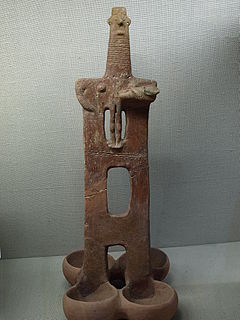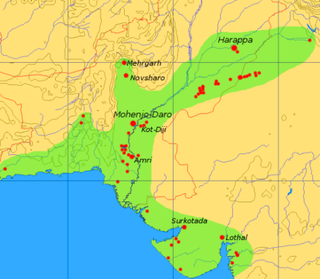
The Bronze Age is a prehistoric period that was characterized by the use of bronze, in some areas proto-writing, and other early features of urban civilization. The Bronze Age is the second principal period of the three-age Stone-Bronze-Iron system, as proposed in modern times by Christian Jürgensen Thomsen, for classifying and studying ancient societies.

Çatalhöyük was a very large Neolithic and Chalcolithic proto-city settlement in southern Anatolia, which existed from approximately 7100 BC to 5700 BC, and flourished around 7000 BC. In July 2012, it was inscribed as a UNESCO World Heritage Site.
The Iron Age is the final epoch of the three-age division of the prehistory and protohistory of humanity. It was preceded by the Bronze Age and the Stone Age. The concept has been mostly applied to Europe and the Ancient Near East, and, by analogy, also to other parts of the Old World.

The Neolithic period is the final division of the Stone Age, with a wide-ranging set of developments that appear to have arisen independently in several parts of the world. It is first seen about 12,000 years ago when the first developments of farming appeared in the Epipalaeolithic Near East, and later in other parts of the world. The Neolithic lasted until the transitional period of the Chalcolithic from about 6,500 years ago, marked by the development of metallurgy, leading up to the Bronze Age and Iron Age.

Troy, also Ilium, was a city in the northwest of Asia Minor, southwest of the Çanakkale Strait, south of the mouth of the Dardanelles and northwest of Mount Ida. The location in the present day is the hill of Hisarlik and its immediate vicinity. In modern scholarly nomenclature, the Ridge of Troy borders the Plain of Troy, flat agricultural land, which conducts the lower Scamander River to the strait. Troy was the setting of the Trojan War described in the Greek Epic Cycle, in particular in the Iliad, one of the two epic poems attributed to Homer. Metrical evidence from the Iliad and the Odyssey suggests that the name Ἴλιον (Ilion) formerly began with a digamma: Ϝίλιον (Wilion); this is also supported by the Hittite name for what is thought to be the same city, Wilusa. According to archaeologist Manfred Korfmann, Troy's location near the Aegean Sea, as well as the Sea of Marmara and the Black Sea, made it a hub for military activities and trade, and the chief site of a culture that Korfmann calls the "Maritime Troja Culture", which extended over the region between these seas.

Kültepe, also known as Kanesh or Nesha, is an archaeological site in Kayseri Province, Turkey. The nearest modern city to Kültepe is Kayseri, about 20 km southwest. It consists of a tell, the actual Kültepe, and a lower town, where an Assyrian settlement was found. Its ancient names are recorded in Assyrian and Hittite sources. In Old Assyrian inscriptions from the 20th and the 19th century BCE, the city was mentioned as Kaneš (Kanesh); in later Hittite inscriptions, the city was mentioned as Neša, or occasionally as Aniša (Anisha). In 2014, the archaeological site was inscribed in the Tentative list of World Heritage Sites in Turkey. It is also the site of discovery of the earliest traces of the Hittite language, the earliest attestation of any Indo-European language, dated to the 20th century BCE.

A hillfort is a type of earthworks used as a fortified refuge or defended settlement, located to exploit a rise in elevation for defensive advantage. They are typically European and of the Bronze Age or Iron Age. Some were used in the post-Roman period. The fortification usually follows the contours of a hill and consists of one or more lines of earthworks, with stockades or defensive walls, and external ditches. Hillforts developed in the Late Bronze and Early Iron Age, roughly the start of the first millennium BC, and were used in many Celtic areas of central and western Europe until the Roman conquest.

The Greek Dark Ages is the period of Greek history from the end of the Mycenaean palatial civilization around 1100 BC to the beginning of Archaic age around 750 BC.

The Bactria–Margiana Archaeological Complex, also known as the Oxus civilization, is the modern archaeological designation for a Bronze Age civilization of Central Asia, dated to c. 2400–1900 BC in its urban phase or Integration Era, located in present-day northern Afghanistan, eastern Turkmenistan, southern Uzbekistan and western Tajikistan, centred on the upper Amu Darya in Bactria, and at Murghab river delta in Margiana. Its sites were discovered and named by the Soviet archaeologist Viktor Sarianidi (1976). Bactria was the Greek name for the area of Bactra, in what is now northern Afghanistan, and Margiana was the Greek name for the Persian satrapy of Marguš, the capital of which was Merv, in modern-day southeastern Turkmenistan.

The Maykop culture, c. 3700 BC–3000 BC, was a major Bronze Age archaeological culture in the western Caucasus region.

The Prehistoric Period is the oldest part of Cypriot history. This article covers the period 10,000 to 800 BC and ends immediately before any written records of civilizations, such as the first mention of Cyprus by the Romans.

The Museum of Anatolian Civilizations is located on the south side of Ankara Castle in the Atpazarı area in Ankara, Turkey. It consists of the old Ottoman Mahmut Paşa bazaar storage building, and the Kurşunlu Han. Because of Atatürk's desire to establish a Hittite museum, the buildings were bought upon the suggestion of Hamit Zübeyir Koşay, who was then Culture Minister, to the National Education Minister, Saffet Arıkan. After the remodelling and repairs were completed (1938–1968), the building was opened to the public as the Ankara Archaeological Museum.

Troy VII is an archaeological layer at Hisarlik which corresponds to the city of Troy from roughly 1300 to 950 BC. It was a walled city comprising a citadel surrounded by a large lower town, described by Manfred Korfmann as "by the standards of its day a large and important city". One of its sublayers has been considered as a candidate for the city which inspired the legends of the Trojan War.

Surkotada is an archaeological site located in Rapar Taluka of Kutch district, Gujarat, India which belongs to the Indus Valley Civilisation (IVC). It is a smaller fortified IVC site with 1.4 hectares in area.

Alacahöyük or Alaca Höyük is the site of a Neolithic and Hittite settlement and is an important archaeological site. It is situated in Alaca, Çorum Province, Turkey, northeast of Boğazkale, where the ancient capital city Hattusa of the Hittite Empire was situated. Its Hittite name is unknown: connections with Arinna, Tawiniya, and Zippalanda have all been suggested.

The European Bronze Age is characterized by bronze artifacts and the use of bronze implements. The regional Bronze Age succeeds the Neolithic. It starts with the Aegean Bronze Age in 3200 BC (succeeded by the Beaker culture), and spans the entire 2nd millennium BC in Northern Europe, lasting until c. 600 BC.

Beycesultan is an archaeological site in western Anatolia, located about 5 km southwest of the modern-day city of Çivril in the Denizli Province of Turkey. It lies in a bend of an old tributary of Büyük Menderes River.

The prehistory of Anatolia stretches from the Paleolithic era through to the appearance of classical civilisation in the middle of the 1st millennium BC. It is generally regarded as being divided into three ages reflecting the dominant materials used for the making of domestic implements and weapons: Stone Age, Bronze Age and Iron Age. The term Copper Age (Chalcolithic) is used to denote the period straddling the stone and Bronze Ages.

Anau culture was an ancient agricultural civilization of Central Asia centred in southern Turkmenistan. It started during the Chalcolithic period around 4000 BC, following the Neolithic Jeitun culture. It is named after its main site of Anau, Turkmenistan.